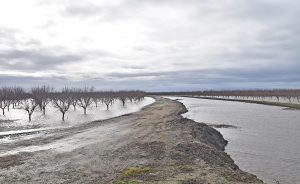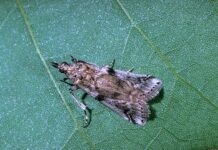
Caused by a group of water molds, Phytophthora root and crown rot in almonds can be a continual challenge brought on by contaminated surface water supplies or poor irrigation practices.
But this year’s near-record rains that caused flooding, prolonged standing water and water-logged soils in late winter and early spring compounded problems, causing substantial damage or mortality to some orchards.
Although a handful of fungicides are labeled to manage Phytophthora root and crown rot, they should not be viewed as standalone treatments but instead part of an integrated approach. It should include selecting tolerant rootstocks, avoiding poorly drained soils, enhancing drainage and proper sprinkler placement and irrigation timing.
Phytophthora crown and root rots are caused by a handful of naturally occurring water molds that favor wet soil conditions.
Of the two, crown rot is more rapid and kills trees by damaging plant tissue that carries water and nutrients from the roots. A telltale symptom of Phytophthora crown rot is leaves on infected trees wilt and dry but remain attached, though there are other diseases which can also produce this symptom, so it is always worth double-checking a field diagnosis.
Root rot, on the other hand, is a chronic problem that slowly kills roots, resulting in decreased tree vigor, stunted tree growth, reduced yields and early leaf drop. Eventually, trees may succumb.

Worst Phytophthora in Memory
Jim Cook, who heads research for Colusa County Farm Supply, said the amount of Phytophthora he saw in almond orchards this spring was the worst he could remember. He quit counting after checking 30 almond orchards, and laboratory tests confirmed his visual observations in all 30.
In addition to the near-record rains, which at times caused creeks and drainage ditches to overflow across rural roadways, Cook pointed to several other possible reasons for increased Phytophthora infections. They include overall larger almond acreage and new orchards planted on marginal soils such as former rice fields that may not have the best drainage. Even some growers who planted on berms to try to keep tree roots and crowns above the water line were unsuccessful, he said.
Water Management is Critical
Jaime Ott, who spent eight years studying Phytophthora before joining UCCE earlier this year, said she was a bit surprised she didn’t receive more grower calls about the disease than she did.
“It may have to do with how prevalent it is in the orchards,” said Ott, who serves Butte, Shasta, Tehama and Glenn counties. “A lot of trees are going to be functioning at a lower capacity even if they don’t show the disease outright.”
As part of her doctoral research, she worked in USDA-ARS Plant Pathologist Greg Browne’s laboratory studying the water mold.
Even in the absence of massive storms, Ott said irrigation practices such as running sets longer than 24 hours and having drip lines next to tree trunks may promote Phytophthora infections within an orchard.

Small trees also are more prone to lethal infections because their smaller trunk circumferences are more easily girdled by the disease than those of mature trees, she said.
This should be kept in mind for potted trees for replants or new orchards that require drip lines to be placed close to the trunk shortly after planting. After about a month, gradually begin moving the lines away, Ott recommended.
“I’ve seen second- or third-leaf trees that still have driplines right against the trunk; you’re just inviting the pathogen,” she said. “Certainly, from a pathology standpoint, you don’t want the dripline right up against the tree because that’s the most susceptible part, the Achilles heel.”
Rootstocks also play a big role in susceptibility, with Marianna 2624 providing the most resistance, followed by intermediate susceptibility from Krymsk 86, Lovell and Nemaguard. Peach almond hybrids like Hansen 536 have high susceptibility.
Although Ott said some consider Krymsk 86 resistant to Phytophthora, she said it hasn’t been proven. Where Krymsk 86 does perform better than some others is in water-logged soils. But in the presence of Phytophthora inoculum, Krymsk 86 can still become infected.
Each rootstock also comes with tradeoffs that growers must weigh. Marianna 2624, for example, is not compatible with Nonpareil or Independence.
Hansen, on the other hand, is compatible with those scion varieties, and is likely why it is so widely planted in the south San Joaquin Valley. But it is highly susceptible to Phytophthora.
Heading into what could be an El Niño winter, Ott recommended growers prepare by performing maintenance to drains, culverts and other conduits that move water away from orchards.
She also pointed to ground cover, whether planted cover crops or native vegetation, as a tool to increase water penetration compared to bare soil in orchards.
“It helps move the water deep into the soil and keeps water from puddling on the surface,” she said.
Based on research from Browne’s lab, she said a single postharvest application of phosphite a month before leaf fall or a single foliar spring application after leaf-out provides trees with several months’ protection from Phytophthora.
It’s also fairly economical and “could be enough to move the balance in your favor,” Ott said.
Opportunity for Trials
This year’s atmospheric rivers allowed Cook to conduct a large-scale field trial using Orondis in a Yolo County almond orchard with many Phytophtora-infected trees. A group 49 fungicide from Syngenta, Orondis contains the active ingredient oxathiapiprolin and received California registration for use on almonds in late 2021. It is labeled for up to two applications per season in established almonds. It also is registered for use at planting on replants and new orchards.
In mature orchards, the label recommends two applications to coincide with root growth flushes, typically February and September. In the trial, Cook said they were about a month late making the spring application because they planned to run it through the irrigation system. The soil was so saturated the grower didn’t want to apply any more water, and they had to wait until the ground dried out a bit.
Out of 50 trees treated with Orondis in the trial, 31 were alive and pushing new growth this summer. Of 50 untreated trees, only four were alive. After one treatment, Cook said the results looked promising, but he was quick to qualify his assessment.
“With some of these young trees that are damaged, the real question comes from an agronomic standpoint of can we make them into productive trees?” he said. “Yes, the trees are alive, and that’s a good thing. But the bottom line is the next part we’re going into now is the production portion and rebuilding the tree.”
Cook compared the current situation to those encountered during a freeze, when trees lose vegetation and hormones promote flushes of new sprouts. To rehabilitate those trees, crews must choose main scaffolds, redo tree architecture and prune out excessive vegetation, a process that may take years. Even then, he said, the trees may never be productive.
“Is it salvageable or should I jerk it out? Am I going to be babysitting that tree for the next 15 years?” Cook said he’s asked by growers. And he doesn’t have an answer.
Even if growers can rehabilitate the above-ground structure, he said they need to keep in mind the root system has been compromised and will be more susceptible to Phytophthora and other soilborne pests for the rest of its life.
The Almond Board of California also is funding research led by UC Riverside Professor Jim Adaskaveg looking at Orondis and two unregistered products, Presidio and Elumin, that could potentially help manage Phytophthora strains that have grown resistant to phosphites.











